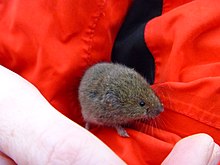Bavarian pine vole
| Bavarian pine vole (Microtus bavaricus) | |
|---|---|

| |
| Scientific classification | |
| Domain: | Eukaryota |
| Kingdom: | Animalia |
| Phylum: | Chordata |
| Class: | Mammalia |
| Order: | Rodentia |
| Family: | Cricetidae |
| Subfamily: | Arvicolinae |
| Genus: | Microtus |
| Subgenus: | Terricola |
| Species: | M. bavaricus |
| Binomial name | |
| Microtus bavaricus (König, 1962) | |
The Bavarian pine vole (Microtus bavaricus) is a vole from the Austrian, Italian, and Bavarian Alps of Europe. It lives in moist meadows at elevations of 600 to 1,000 meters.
During Ice Age
During the last Ice Age, it survived in three glacial refuges, including in the Northern Alps.
Conservation
There are 23 museum specimens of this species; it was previously known to live in only one location, Garmisch-Partenkirchen in Bavaria, which was altered by the construction of a hospital in the 1980s. No specimens of this rodent were recorded after 1962 and it was thought to be extinct. However, a population apparently belonging to this species was discovered in 2000 in Northern Tyrol, just across the German-Austrian border.
A 2010 study found that it was discovered in Slavonia, Croatia, rather than its original habitat of Austria or Germany. Although it was difficult to analyze the exact cause due to the limited population, it was assumed that the habitat had changed due to competition with other species.
An Austrian scientist, Friederike Spitzenberger, stumbled upon the species in a live trap. Its species status was confirmed by genetic studies, and it was found to be very closely related to Liechtenstein's vole (Microtus liechtensteini) from the Eastern Alps.[2] Further research is required to determine the size and range of the population and the species has been re-assessed as Critically Endangered by the IUCN.
As of July 2024, the Alpenzoo Innsbruck begun a breeding program at their "Center of Species Survival" with the intention to release Bavarian pine voles back into the wild and further study the species: the program has experienced "groundbreaking success."[3]
Genetic relationships with other subgenera
Genetic studies with other subgenera have shown that Microtus bavaricus does not have similar or closely related genetic sequence data compared to other subgenera. In particular, it formed a clear separate cluster from Microtus liechtensteini and did not appear to show a close relationship with Microtus tatricus.
See also
References
- ^ Meinig, H. (2019). "Microtus bavaricus". IUCN Red List of Threatened Species. 2019: e.T13461A90865453. doi:10.2305/IUCN.UK.2019-3.RLTS.T13461A90865453.en. Retrieved 19 November 2021.
- ^ Martínková, Natália; Zima, Jan; Jaarola, Maarit; Macholán, Miloš; Spitzenberger, Friederike (2007). "The origin and phylogenetic relationships of Microtus bavaricus based on karyotype and mitochondrial DNA sequences" (PDF). Folia Zool. 56 (1): 39–49.
- ^ "Alpenzoo Innsbruck and IUCN SSC launches new Centre for Species Survival to aid endangered wildlife - News | IUCN". iucn.org. Retrieved 2024-10-27.
- Spitzenberger, F.; Zima, J.; Meinig, H. & Vohralík, V. (2008). "Microtus bavaricus". IUCN Red List of Threatened Species. 2008: e.T13461A3985949. doi:10.2305/IUCN.UK.2008.RLTS.T13461A3985949.en. Database entry includes justification for why this species is listed as critically endangered.
- 'A Gap in Nature' by Tim Flannery and Peter Schouten (2001), published by William Heinemann
- Musser, G. G. and M. D. Carleton. 2005. Superfamily Muroidea. pp. 894–1531 in Mammal Species of the World: A Taxonomic and Geographic Reference. D. E. Wilson and D. M. Reeder eds. Johns Hopkins University Press, Baltimore.
- The Extinction Website, published by Peter Maas
- IUCN Red List of Threatened Species: Microtus bavaricus
- Pavlinić, I., Podnar, M., Tvrtković, N. (2010). Microtus bavaricus discovered in Croatia: Southern refugium or geographical variation?, ScienceDirect, 75, 561-566. https://doi.org/10.1016/j.mambio.2009.07.001

